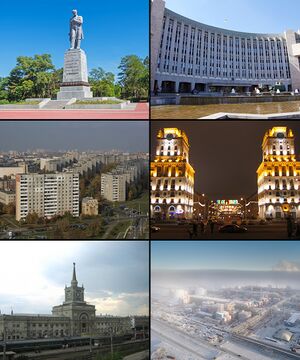Kaposvár
This article is incomplete because it is pending further input from participants, or it is a work-in-progress by one author. Please comment on this article's talk page to share your input, comments and questions. Note: To contribute to this article, you may need to seek help from the author(s) of this page. |
Kaposvár
Ruvelkan: Űiũīḻṻíṷ | |
|---|---|
City | |
 Clockwise from top: András Váradi park; Kaposvár city hall; Central Commerce Street; Sabetta oil processing plant; Kaposvár Railway Station; Apartment complexes in downtown Kaposvár. | |
| Country | |
| District | Kunhegyes District |
| Founded | 1456 CE |
| Government | |
| • Body | Kaposvár Duma |
| • Head | Martina Varga |
| Area | |
| • Total | 1,011.6 km2 (390.6 sq mi) |
| Elevation | 80 m (260 ft) |
| Highest elevation | 153 m (502 ft) |
| Population (2019) | |
| • Total | 1,021,215 |
Kaposvár (Ruvelkan Script: Űiũīḻṻíṷ) is an industrial city located in the center of the North Koryal Plain. With a population of 1,021,215, it is the second-largest city of the Kunhegyes District. The city was originally founded in 1456 as an outpost fortress for the Duchy of Moravskoslezsky and a lookout for incursions made by neighboring Makedonia. For much of its early history, Kaposvár served as a small military town and trading post for travelers coming to and from the northern coast.
In the mid 1800s, the Koryal Plain was discovered to be rich in petroleum and Kaposvár rapidly grew to become the industrial heart of northwestern Ruvelka. By 1860, the population of Kaposvár had exploded exponentially making it one of the largest cities in the Ruvelkan Imperium at the time.
Political tension opposing the Imperial Convention’s conservatism began spreading discontent among the populace, primarily centered among the working class in Kaposvár. An armed uprising led by András Váradi resulted in the Red War and the creation of the Ruvelkan Socialist Republic. Between 1865 and 1918, Kaposvár served as the national capital of the Socialist Republic. After the Ruvelkan Civil War, the capital was returned to Debrecen.
The city continues to be a major industrial center for Ruvelka in the modern-era and saw extensive fighting during the Zemplen War.